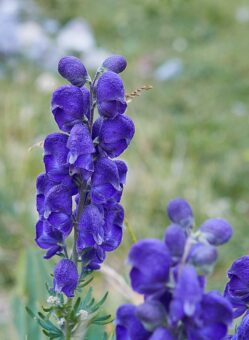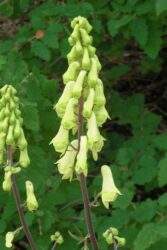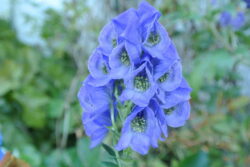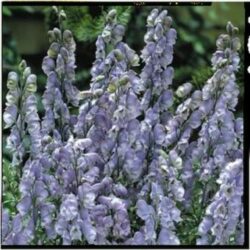In this article, we will discuss how to grow the notorious Aconitum in containers. You may wonder why I have called Aconitum or Monkshood, Wolfsbane or Aconite to give its common names, as notorious, the answer is because it has a reputation of being toxic to humans, with the possibility of death.
This is exaggerated as very few gardeners die after handling it, as long as you do it with great care.

It is a firm favourite that in nature is found growing in meadows throughout the Northern hemisphere. It is grown for its deeply divided green leaves and for the spikes of helmet-shaped (Monkshood) flowers that are produced. The flowers are usually blue but other shades of near blue are possible.
The common name of Monkshood comes about as the shape of the outer petals of the flower resembles cowls (headwear) worn by monks. Rarer species and varieties can produce yellow or white flowers but these are not seen often.
This is one plant that does not like to be disturbed as it can take a while for the plant to establish. Only divide in autumn in containers if the plant is looking too crowded. This should take a while as it is a slow-growing plant.
GROWING MONKSHOOD IN CONTAINERS
Monkshood is normally bought as garden-ready pot plants and not normally reared from seeds, as it has such poor germination rates.
It is best to buy new plants in early springs. To really do well, it is best to imitate the growing conditions in its natural environment.

First, select a container that will suit the Aconitum in question, in terms of size and colour. Whatever you choose make sure it has plenty of drainage holes at the bottom. To the bottom of the container, add a 1cm layer of gravel as this will help with water draining. To this, add multipurpose compost to near the top. Dig a hole that is slightly bigger than the root ball it came in the original container.
Place a plant in so that the top of the root ball is at the same level as the top surface of the compost. Backfill with the growing media, making sure that no gaps remain (use more compost if you have to). Firm the plant in and water well.
At the planting stage, do not add any fertilizer as too much rich soil will encourage the plant to grow too lanky. Make sure that the compost is never too moist at all times, as the fragile roots will rot in too much water.
Only water when 5cm below the top surface of the compost feels dry to the touch, or if it is wilting because the compost is too dry.
THIS IS ONE TOXIC PLANT
One thing that must be remembered is that all parts of the plant are toxic, as they contain aconitine. This aconitine was used to align weapons to kill wolves (hence its other common name of Wolfsbane). When planting or handling, make sure you wear gloves to minimise sap passing through the skin. Never consume this plant as it can be fatal.

For best results, it is advised to grow it in light shade, as this will benefit the plant and stop it from getting too hot as the plant does not like it.
The plant may need to be stalked, especially the tall varieties to stop it from getting wind damaged and from flopping all over the place. As it does not self-seed regularly, there is no need to cut the spent flowering spikes. In autumn, when the leaves have dieback, you can cut the whole plant, leaves and spent flowers close to the crown.
Monkshood has a tendency to form gaps in the centre with time. To minimise this, split the plant every few years and dispose of the centre and create divisions from the outer plant. These divisions can be planted in new containers to add to your or your friend’s collection.
You can give your plant an annual dressing of slow-release fertilizer to give the plants a boost through the growing season.
PESTS AND DISEASES
Luckily no pest will attack the plant due to its toxic nature but it can suffer from powdery mildew. This is especially true if the compost is allowed to dry too much. To avoid this, improve air circulation between the stems of the plant and around the plant.
VARIETIES TO GROW
The two main species you will find are based on Aconitum carmichaelii and Aconitum napellus. ‘Album’ is the white variety to grow for its unique coloured flowers.

The one to choose is Aconitum ‘Spark’s Variety’ that produces dark blue-purple flowers and ‘Bressingham Spire’ that has lighter violet-blue flowers.
An interesting species is Aconitum x cammarum which produces tall spikes of white and violet-blue flowers.
The main group is based on Aconitum carmichaelii which includes ‘Kelmstott’ that produces lavender-blue bloom, ‘Arendsii’ that produces a rich blue colour and ‘Barker’s Variety’ that produced tall spikes of soft blue flowers.
If you are looking for something that is completely different then Aconitum ‘Ivorine’ is the plant for you. Instead of the blue coloured flowers common for the other Aconitums, it produces pale yellow flowers that are produced earlier than the others.
CONCLUSIONS
In this article, we have discussed how to grow the beautiful but deadly Aconitum in containers. They are such wonderful colourful plants as long as you are prepared to take precautions and avoid touching them with your bare hands, they tend to be easy to grow, easy to look after and very pleasing to the eye. What more can you ask for.
A plant that is well worth growing if you do not have pets or children to worry about.
If you have any questions or comments that you wish to make on growing Acontinum in containers, please do so in the comment box below.
Happy Monkshood growing.
